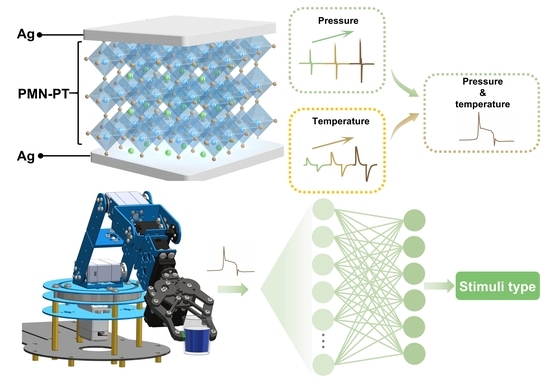Self-Powered Pressure–Temperature Bimodal Sensing Based on the Piezo-Pyroelectric Effect for Robotic Perception
Abstract
:1. Introduction
2. Materials and Methods
2.1. Preparation of the Bimodal PMN-PT Sensor
2.2. Characterizations of the Bimodal PMN-PT Sensor
3. Results
3.1. Design Concept and Device Structure
3.2. Self-Powered Pressure Sensing
3.3. Self-Powered Temperature Sensing
3.4. Simultaneous Pressure and Temperature Sensing
3.5. Self-Powered Pressure–Temperature Sensing for Robotic Stimuli Classification
4. Conclusions
Supplementary Materials
Author Contributions
Funding
Institutional Review Board Statement
Informed Consent Statement
Data Availability Statement
Conflicts of Interest
References
- Han, Y.; Song, L.; Du, H.; Wang, G.; Zhang, T.; Ni, L.; Li, Y. Enhancing Structural Response via Macro-Micro Hierarchy for Piezoelectric Nanogenerator and Self-Powered Searable Controller. Chem. Eng. J. 2024, 481, 148729. [Google Scholar] [CrossRef]
- Yan, D.; Wang, J.; Xiang, J.; Xing, Y.; Shao, L.-H. A Flexoelectricity-Enabled Ultrahigh Piezoelectric Effect of a Polymeric Composite Foam as a Strain-Gradient Electric Generator. Sci. Adv. 2023, 9, eadc8845. [Google Scholar] [CrossRef]
- Xu, Q.; Wang, Z.; Zhong, J.; Yan, M.; Zhao, S.; Gong, J.; Feng, K.; Zhang, J.; Zhou, K.; Xie, J.; et al. Construction of Flexible Piezoceramic Array with Ultrahigh Piezoelectricity via a Hierarchical Design Strategy. Adv. Funct. Mater. 2023, 33, 2304402. [Google Scholar] [CrossRef]
- Song, L.; Huang, Z.; Guo, S.; Li, Y.; Wang, Q. Hierarchically Architected Polyvinylidene Fluoride Piezoelectric Foam for Boosted Mechanical Energy Harvesting and Self-Powered Sensor. ACS Appl. Mater. Interfaces 2021, 13, 37252–37261. [Google Scholar] [CrossRef]
- Yan, M.; Zhong, J.; Liu, S.; Xiao, Z.; Yuan, X.; Zhai, D.; Zhou, K.; Li, Z.; Zhang, D.; Bowen, C.; et al. Flexible Pillar-Base Structured Piezocomposite with Aligned Porosity for Piezoelectric Energy Harvesting. Nano Energy 2021, 88, 106278. [Google Scholar] [CrossRef]
- Jiang, H.; Song, L.; Huang, Z.-X.; Liu, M.; Zhao, Y.; Zhang, S.; Guo, J.; Li, Y.; Wang, Q.; Qu, J.-P. A Novel Concept of Hierarchical Porous Structural Design on Enhancing Output Performance of Piezoelectric Nanogenerator. Nano Energy 2022, 104, 107921. [Google Scholar] [CrossRef]
- Li, G.-Y.; Li, J.; Li, Z.-J.; Zhang, Y.-P.; Zhang, X.; Wang, Z.-J.; Han, W.-P.; Sun, B.; Long, Y.-Z.; Zhang, H.-D. Hierarchical PVDF-HFP/ZnO Composite Nanofiber-based Highly Sensitive Piezoelectric Sensor for Wireless Workout Monitoring. Adv. Compos. Hybrid. Mater. 2022, 5, 766–775. [Google Scholar] [CrossRef]
- Zeng, W.; Deng, W.; Yang, T.; Wang, S.; Sun, Y.; Zhang, J.; Ren, X.; Jin, L.; Tang, L.; Yang, W. Gradient CNT/PVDF Piezoelectric Composite with Enhanced Force-Electric Coupling for Soccer Training. Nano Res. 2023, 16, 11312–11319. [Google Scholar] [CrossRef]
- Hong, Y.; Wang, B.; Long, Z.; Zhang, Z.; Pan, Q.; Liu, S.; Luo, X.; Yang, Z. Hierarchically Interconnected Piezoceramic Textile with a Balanced Performance in Piezoelectricity, Flexibility, Toughness, and Air Permeability. Adv. Funct. Mater. 2021, 31, 2104737. [Google Scholar] [CrossRef]
- Li, Y.; Sun, J.; Li, P.; Li, X.; Tan, J.; Zhang, H.; Li, T.; Liang, J.; Zhou, Y.; Hai, Z.; et al. High-Performance Piezoelectric Nanogenerators Based on Hierarchical ZnO@CF/PVDF Composite Film for Self-Powered Meteorological Sensor. J. Mater. Chem. A 2023, 11, 13708–13719. [Google Scholar] [CrossRef]
- Kim, D.W.; Kim, H.; Hwang, G.-T.; Cho, S.B.; Jeon, S.H.; Kim, H.W.; Jeong, C.K.; Chun, S.; Pang, C. Conformably Skin-Adherent Piezoelectric Patch with Bioinspired Hierarchically Arrayed Microsuckers Enables Physical Energy Amplification. ACS Energy Lett. 2022, 7, 1820–1827. [Google Scholar] [CrossRef]
- Fu, J.Y.; Zhu, W.; Li, N.; Smith, N.B.; Eric Cross, L. Gradient Scaling Phenomenon in Microsize Flexoelectric Piezoelectric Composites. Appl. Phys. Lett. 2007, 91, 182910. [Google Scholar] [CrossRef]
- Yang, T.; Deng, W.; Tian, G.; Deng, L.; Zeng, W.; Wu, Y.; Wang, S.; Zhang, J.; Lan, B.; Sun, Y.; et al. Modulating Piezoelectricity and Mechanical Strength via Three-Dimensional Gradient Structure for Piezoelectric Composites. Mater. Horiz. 2023, 10, 5045–5052. [Google Scholar] [CrossRef] [PubMed]
- Liu, H.; Lin, X.; Zhang, S.; Huan, Y.; Huang, S.; Cheng, X. Enhanced Performance of Piezoelectric Composite Nanogenerator Based on Gradient Porous PZT Ceramic Structure for Energy Harvesting. J. Mater. Chem. A 2020, 8, 19631–19640. [Google Scholar] [CrossRef]
- Malakooti, M.H.; Zhou, Z.; Spears, J.H.; Shankwitz, T.J.; Sodano, H.A. Biomimetic Nanostructured Interfaces for Hierarchical Composites. Adv. Mater. Interfaces 2016, 3, 1500404. [Google Scholar] [CrossRef]
- Gottscholl, A.; Diez, M.; Soltamov, V.; Kasper, C.; Krauße, D.; Sperlich, A.; Kianinia, M.; Bradac, C.; Aharonovich, I.; Dyakonov, V. Spin Defects in hBN as Promising Temperature, Pressure and Magnetic Field Quantum Sensors. Nat. Commun. 2021, 12, 4480. [Google Scholar] [CrossRef]
- Zhang, F.; Zang, Y.; Huang, D.; Di, C.-a.; Zhu, D. Flexible and Self-Powered Temperature-Pressure Dual-Parameter Sensors Using Microstructure-Frame-Supported Organic Thermoelectric Materials. Nat. Commun. 2015, 6, 8356. [Google Scholar] [CrossRef]
- Wang, Y.; Wu, H.; Xu, L.; Zhang, H.; Yang, Y.; Wang, Z.L. Hierarchically Patterned Self-Powered Sensors for Multifunctional Tactile Sensing. Sci. Adv. 2020, 6, eabb9083. [Google Scholar] [CrossRef]
- Wen, L.; Nie, M.; Wang, C.; Zhao, Y.-n.; Yin, K.; Sun, L. Multifunctional, Light-Weight Wearable Sensor Based on 3D Porous Polyurethane Sponge Coated with MXene and Carbon Nanotubes Composites. Adv. Mater. Interfaces 2022, 9, 2101592. [Google Scholar] [CrossRef]
- Fu, X.; Zhuang, Z.; Zhao, Y.; Liu, B.; Liao, Y.; Yu, Z.; Yang, P.; Liu, K. Stretchable and Self-Powered Temperature-Pressure Dual Sensing Ionic Skins Based on Thermogalvanic Hydrogels. ACS Appl. Mater. Interfaces 2022, 14, 44792–44798. [Google Scholar] [CrossRef]
- Ji, Y.; Wang, Y.; Yang, Y. Photovoltaic-Pyroelectric-Piezoelectric Coupled Effect Induced Electricity for Self-Powered Coupled Sensing. Adv. Electron. Mater. 2019, 5, 1900195. [Google Scholar] [CrossRef]
- Shin, Y.-E.; Park, Y.-J.; Ghosh, S.K.; Lee, Y.; Park, J.; Ko, H. Ultrasensitive Multimodal Tactile Sensors with Skin-Inspired Microstructures through Localized Ferroelectric Polarization. Adv. Sci. 2022, 9, 2105423. [Google Scholar] [CrossRef] [PubMed]
- Park, J.; Kim, M.; Lee, Y.; Lee, H.S.; Ko, H. Fingertip Skin-Inspired Microstructured Ferroelectric Skins Discriminate Static/Dynamic Pressure and Temperature Stimuli. Sci. Adv. 2015, 1, e1500661. [Google Scholar] [CrossRef]
- Zhu, P.; Wang, Y.; Wang, Y.; Mao, H.; Zhang, Q.; Deng, Y. Flexible 3D Architectured Piezo/Thermoelectric Bimodal Tactile Sensor Array for E-Skin Application. Adv. Energy Mater 2020, 10, 2001945. [Google Scholar] [CrossRef]
- Zhao, K.; Ouyang, B.; Bowen, C.R.; Wang, Z.L.; Yang, Y. One-Structure-Based Multi-effects Coupled Nanogenerators for Flexible and Self-Powered Multi-Functional Coupled Sensor Systems. Nano Energy 2020, 71, 104632. [Google Scholar] [CrossRef]
- Ghosh, S.K.; Park, J.; Na, S.; Kim, M.P.; Ko, H. A Fully Biodegradable Ferroelectric Skin Sensor from Edible Porcine Skin Gelatine. Adv. Sci. 2021, 8, 2005010. [Google Scholar] [CrossRef]
- Zirkl, M.; Sawatdee, A.; Helbig, U.; Krause, M.; Scheipl, G.; Kraker, E.; Ersman, P.A.; Nilsson, D.; Platt, D.; Bodö, P.; et al. An All-Printed Ferroelectric Active Matrix Sensor Network Based on Only Five Functional Materials Forming a Touchless Control Interface. Adv. Mater. 2011, 23, 2069–2074. [Google Scholar] [CrossRef]
- Roy, K.; Ghosh, S.K.; Sultana, A.; Garain, S.; Xie, M.; Bowen, C.R.; Henkel, K.; Schmeiβer, D.; Mandal, D. A Self-Powered Wearable Pressure Sensor and Pyroelectric Breathing Sensor Based on GO Interfaced PVDF Nanofibers. ACS Appl. Nano Mater. 2019, 2, 2013–2025. [Google Scholar] [CrossRef]
- Ali, T.A.; Groten, J.; Clade, J.; Collin, D.; Schäffner, P.; Zirkl, M.; Coclite, A.-M.; Domann, G.; Stadlober, B. Screen-Printed Ferroelectric P(VDF-TrFE)-co-PbTiO3 and P(VDF-TrFE)-co-NaBiTi2O6 Nanocomposites for Selective Temperature and Pressure Sensing. ACS Appl. Mater. Interfaces 2020, 12, 38614–38625. [Google Scholar] [CrossRef]
- Lee, J.-H.; Lee, K.Y.; Gupta, M.K.; Kim, T.Y.; Lee, D.-Y.; Oh, J.; Ryu, C.; Yoo, W.J.; Kang, C.-Y.; Yoon, S.-J.; et al. Highly Stretchable Piezoelectric-Pyroelectric Hybrid Nanogenerator. Adv. Mater. 2014, 26, 765–769. [Google Scholar] [CrossRef]
- Yao, K.; Chen, S.; Lai, S.C.; Yousry, Y.M. Enabling Distributed Intelligence with Ferroelectric Multifunctionalities. Adv. Sci. 2022, 9, 2103842. [Google Scholar] [CrossRef] [PubMed]
- Song, K.; Zhao, R.; Wang, Z.L.; Yang, Y. Conjuncted Pyro-Piezoelectric Effect for Self-Powered Simultaneous Temperature and Pressure Sensing. Adv. Mater. 2019, 31, 1902831. [Google Scholar] [CrossRef] [PubMed]
- Chen, C.; Wang, Y.; Li, J.; Wu, C.; Yang, G. Piezoelectric, Ferroelectric and Pyroelectric Properties of (100-x)Pb(Mg1/3Nb2/3)O3-xPbTiO3 Ceramics. J. Adv. Dielectr. 2022, 12, 2250002. [Google Scholar] [CrossRef]
- Kelly, J.; Leonard, M.; Tantigate, C.; Safari, A. Effect of Composition on the Electromechanical Properties of (1-x)Pb(Mg1/3Nb2/3)O3-XPbTiO3 Ceramics. J. Am. Ceram. Soc. 1997, 80, 957–964. [Google Scholar] [CrossRef]
- Feng, Z.; Li, H.; Luo, H.; Jin, W. High Electric-Field-Induced Strain Beahvior of Single-Crystal Pb(Mg1/3Nb2/3)O3-xPbTiO3 Multilayer Piezoelectric Actuators. J. Electron. Mater. 2005, 34, 1035–1039. [Google Scholar] [CrossRef]
- Luo, N.; Zhang, S.; Li, Q.; Yan, Q.; He, W.; Zhang, Y.; Shrout, T.R. PMN-PT Based Quaternary Piezoceramics with Enhanced Piezoelectricity and Temperature Stability. Appl. Phys. Lett. 2014, 104, 182911. [Google Scholar] [CrossRef]
- Lv, P.; Qian, J.; Yang, C.; Liu, T.; Wang, Y.; Wang, D.; Huang, S.; Cheng, X.; Cheng, Z. Flexible All-Inorganic Sm-Doped PMN-PT Film with Ultrahigh Piezoelectric Coefficient for Mechanical Energy Harvesting, Motion Sensing, and Human-Machine Interaction. Nano Energy 2022, 97, 107182. [Google Scholar] [CrossRef]
- Chen, Y.; Zhang, Y.; Yuan, F.; Ding, F.; Schmidt, O.G. A Flexible PMN-PT Ribbon-Based Piezoelectric-Pyroelectric Hybrid Generator for Human-Activity Energy Harvesting and Monitoring. Adv. Electron. Mater 2017, 3, 1600540. [Google Scholar] [CrossRef]
- Bowen, C.R.; Taylor, J.; LeBoulbar, E.; Zabek, D.; Chauhan, A.; Vaish, R. Pyroelectric Materials and Devices for Energy Harvesting Applications. Energ. Environ. Sci 2014, 7, 3836–3856. [Google Scholar] [CrossRef]
- Zhao, J.; Zhu, R.; Chen, J.; Zhang, M.; Feng, P.; Jiao, J.; Wang, X.a.; Luo, H. Enhanced Temperature Stability of Compensated Pyroelectric Infrared Detector based on Mn:PMN-PT Single Crystals. Sensor. Actuat. A-Phys. 2021, 327, 112757. [Google Scholar] [CrossRef]
- Kandilian, R.; Navid, A.; Pilon, L. The Pyroelectric Energy Harvesting Capabilities of PMN-PT near the Morphotropic Phase Boundary. Smart Mater. Struct. 2011, 20, 055020. [Google Scholar] [CrossRef]
- Zhao, X.; Dai, J.Y.; Wang, J.; Chan, H.L.W.; Choy, C.L.; Wan, X.M.; Luo, H.S. Relaxor Ferroelectric Characteristics and Temperature-Dependent Domain Structure in a (110)-Cut (PbMg1/3Nb2/3)0.75(PbTiO3)0.25 Single Crystal. Phys. Rev. B 2005, 72, 064114. [Google Scholar] [CrossRef]
- Wu, N.; Song, X.; Hou, Y.; Zhu, M.; Wang, C.; Yan, H. Relaxor Behavior of (1-x)Pb(Mg1/3Nb2/3)O3-xPbTiO3 Ceramics. Chin. Sci. Bull. 2009, 54, 1267–1274. [Google Scholar] [CrossRef]
- Ma, N.; Zhang, K.; Yang, Y. Photovoltaic-Pyroelectric Coupled Effect Induced Electricity for Self-Powered Photodetector System. Adv. Mater. 2017, 29, 1703694. [Google Scholar] [CrossRef]
- Shin, Y.-E.; Sohn, S.-D.; Han, H.; Park, Y.; Shin, H.-J.; Ko, H. Self-Powered Triboelectric/Pyroelectric Multimodal Sensors with Enhanced Performances and Decoupled Multiple Stimuli. Nano Energy 2020, 72, 104671. [Google Scholar] [CrossRef]
- Liu, W.; Lin, D.; Zeng, W.; Wang, Q.; Yang, J.; Peng, Z.; Zhang, Q.; Zhu, G. A Multifunctional Flexible Ferroelectric Transistor Sensor for Electronic Skin. Adv. Mater. Interfaces 2021, 8, 2101166. [Google Scholar] [CrossRef]
- Kim, J.; Jang, M.; Jeong, G.; Yu, S.; Park, J.; Lee, Y.; Cho, S.; Yeom, J.; Lee, Y.; Choe, A.; et al. MXene-Enhanced β-Phase Crystallization in Ferroelectric Porous Composites for Highly-Sensitive Dynamic Force Sensors. Nano Energy 2021, 89, 106409. [Google Scholar] [CrossRef]
- Eom, K.; Na, S.; Kim, J.-K.; Ko, H.; Jin, J.; Kang, S.J. Engineering Crystal Phase of Nylon-11 Films for Ferroelectric Device and Piezoelectric Sensor. Nano Energy 2021, 88, 106244. [Google Scholar] [CrossRef]
- Li, W.; Li, C.; Zhang, G.; Li, L.; Huang, K.; Gong, X.; Zhang, C.; Zheng, A.; Tang, Y.; Wang, Z.; et al. Molecular Ferroelectric-Based Flexible Sensors Exhibiting Supersensitivity and Multimodal Capability for Detection. Adv. Mater. 2021, 33, 2104107. [Google Scholar] [CrossRef]
- Eom, K.; Shin, Y.-E.; Kim, J.-K.; Joo, S.H.; Kim, K.; Kwak, S.K.; Ko, H.; Jin, J.; Kang, S.J. Tailored Poly(vinylidene fluoride-co-trifluoroethylene) Crystal Orientation for a Triboelectric Nanogenerator through Epitaxial Growth on a Chitin Nanofiber Film. Nano Letters 2020, 20, 6651–6659. [Google Scholar] [CrossRef]
- Zhou, B.; Li, C.; Zhou, Y.; Liu, Z.; Gao, X.; Wang, X.; Jiang, L.; Tian, M.; Zhou, F.-L.; Jerrams, S.; et al. A Flexible Dual-Mode Pressure Sensor with Ultra-High Sensitivity based on BTO@MWCNTs Core-Shell Nanofibers. Compos. Sci.Technol. 2022, 224, 109478. [Google Scholar] [CrossRef]
- Zhao, K.; Zhang, H.; Meng, J.; Chung, C.-C.; Gu, B.-N.; Liu, M.-J.; Zhang, D.; Zhong, M.; Liu, M.; Liu, N.; et al. Design of Self-Powered Sensors with Excellent Thermal and UV-Light Detections by 0.94(Bi0.5Na0.5)TiO3-0.06Ba(Zr0.25Ti0.75)O3 Nanoparticles. Adv. Funct. Mater. 2022, 32, 2204234. [Google Scholar] [CrossRef]


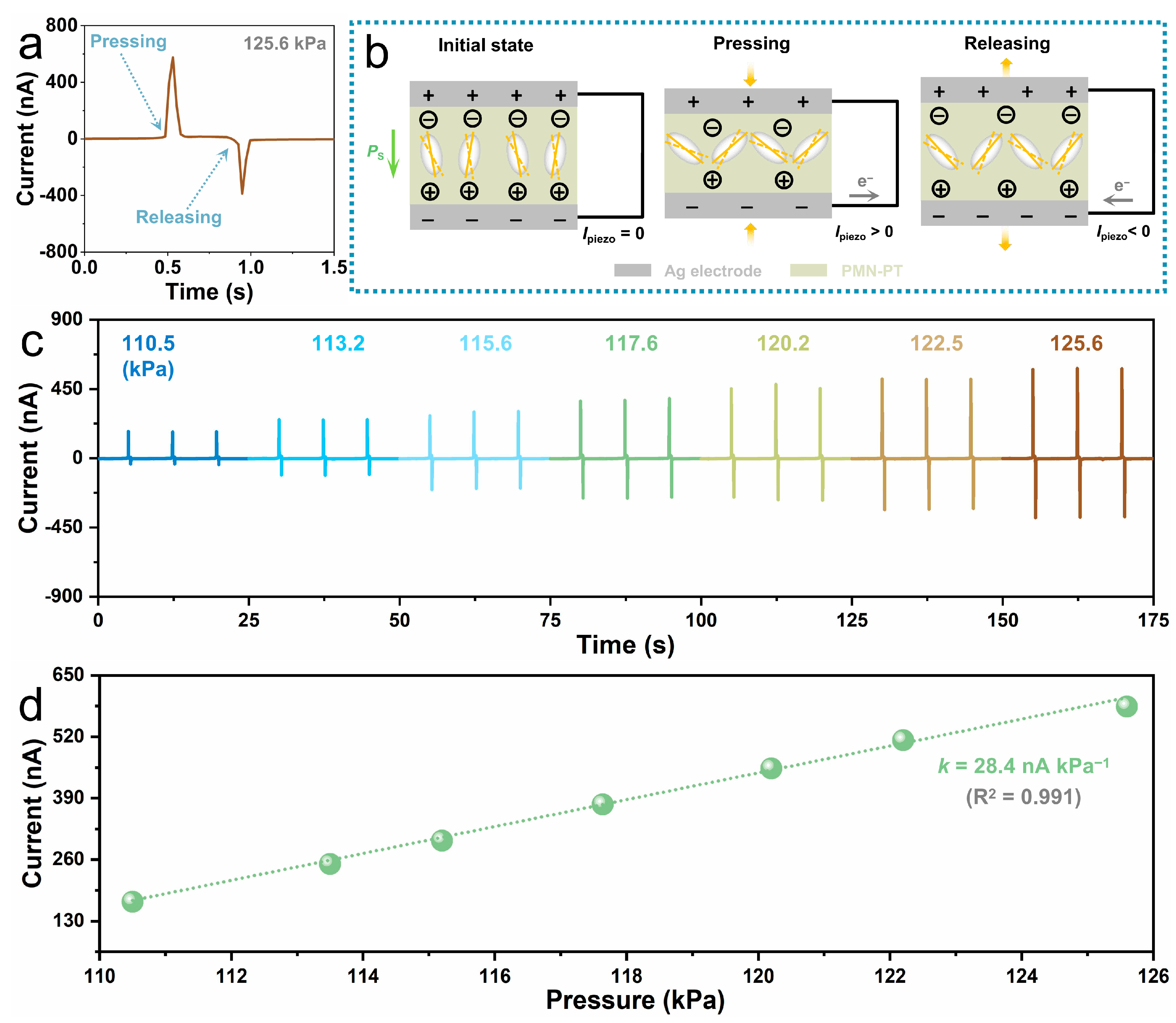
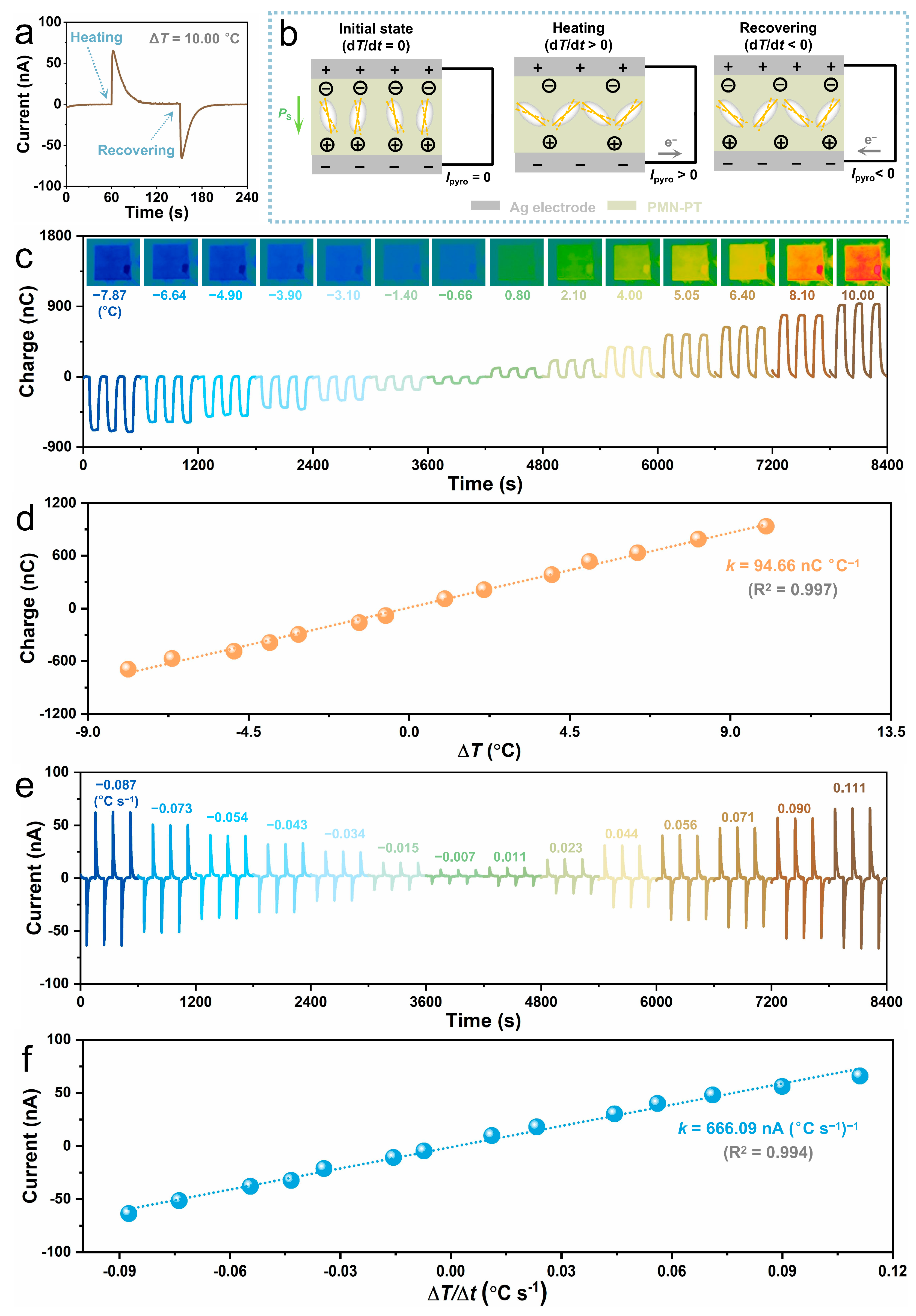
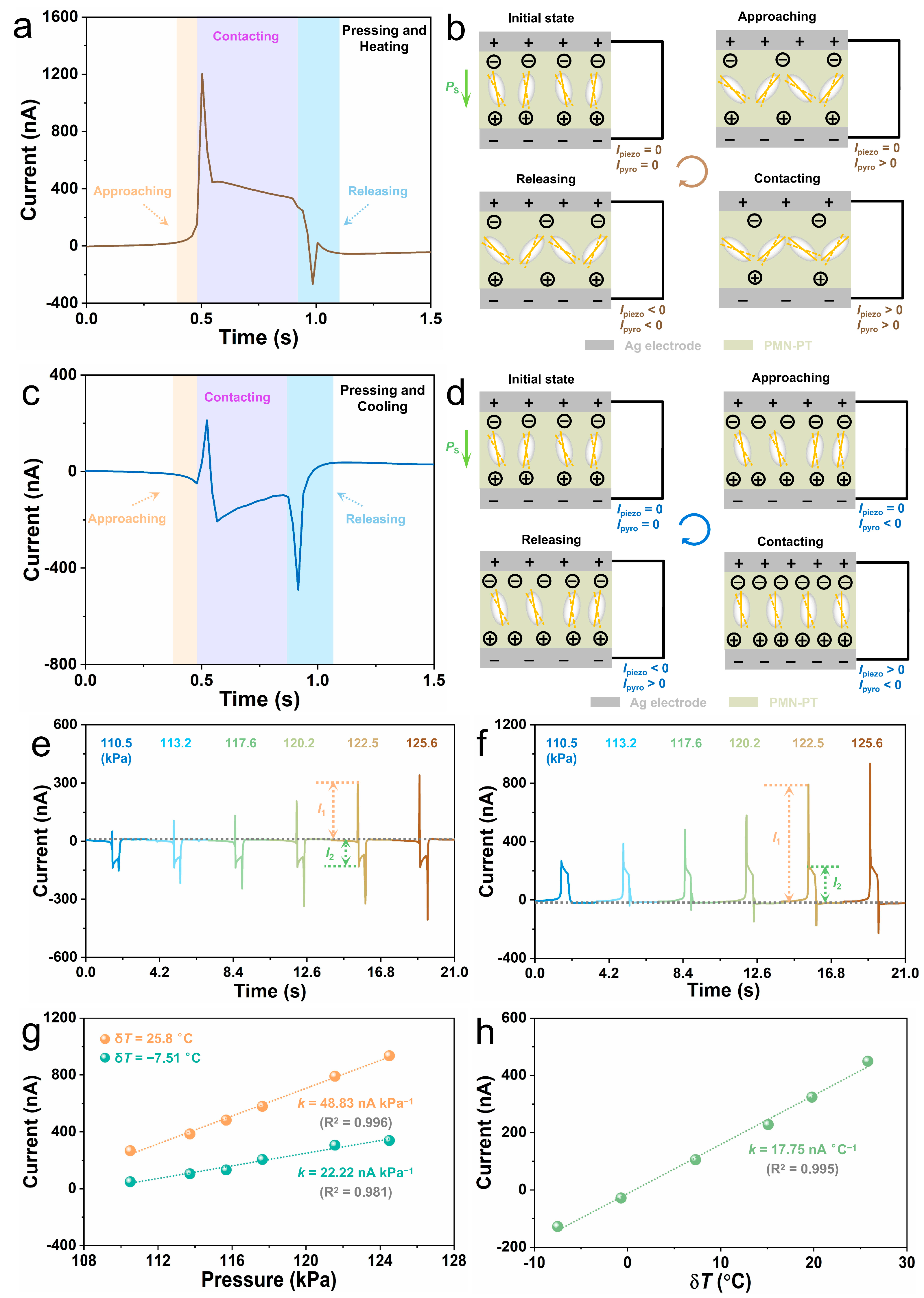

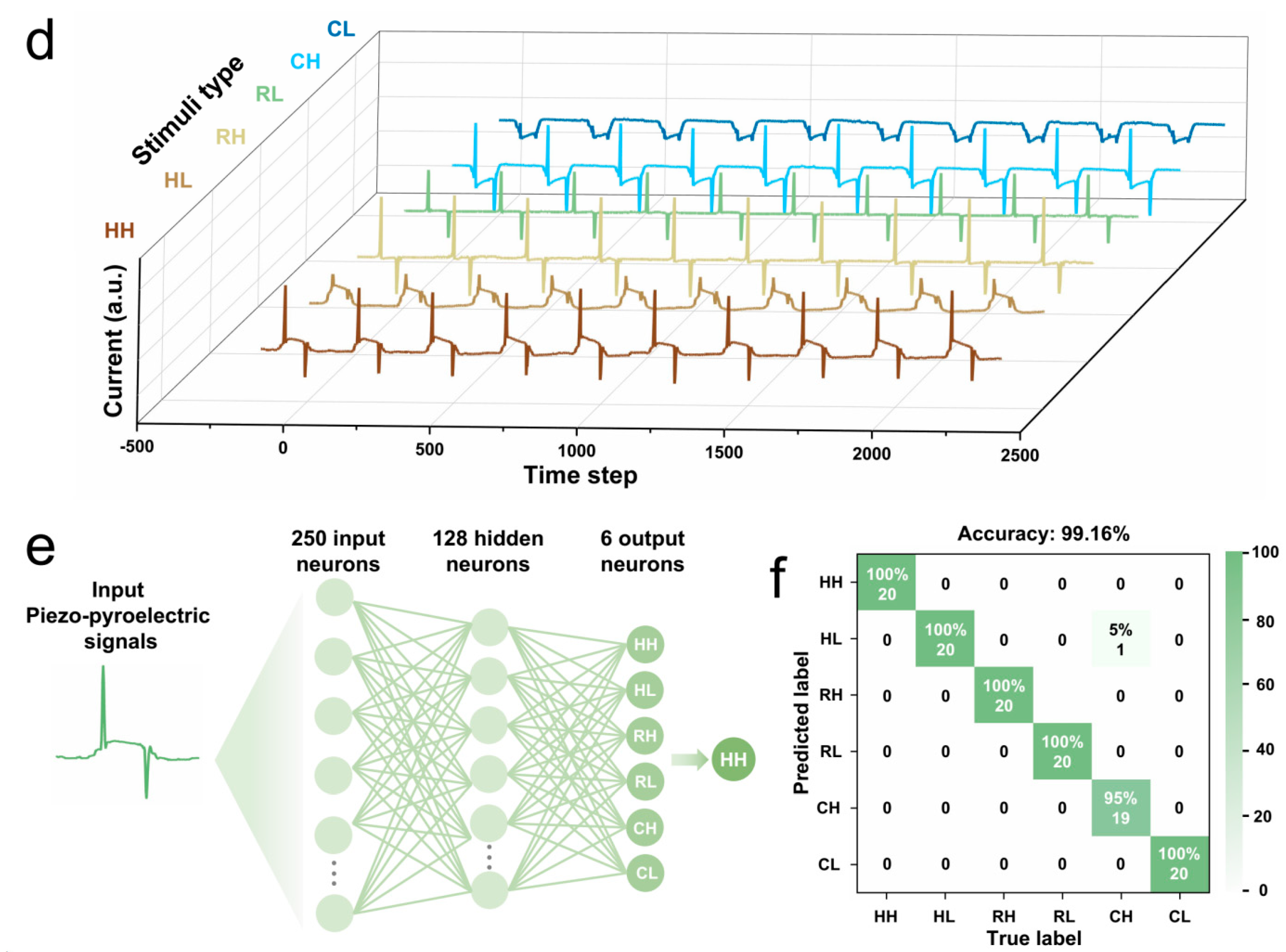
Disclaimer/Publisher’s Note: The statements, opinions and data contained in all publications are solely those of the individual author(s) and contributor(s) and not of MDPI and/or the editor(s). MDPI and/or the editor(s) disclaim responsibility for any injury to people or property resulting from any ideas, methods, instructions or products referred to in the content. |
© 2024 by the authors. Licensee MDPI, Basel, Switzerland. This article is an open access article distributed under the terms and conditions of the Creative Commons Attribution (CC BY) license (https://creativecommons.org/licenses/by/4.0/).
Share and Cite
Yu, X.; Ji, Y.; Shen, X.; Le, X. Self-Powered Pressure–Temperature Bimodal Sensing Based on the Piezo-Pyroelectric Effect for Robotic Perception. Sensors 2024, 24, 2773. https://doi.org/10.3390/s24092773
Yu X, Ji Y, Shen X, Le X. Self-Powered Pressure–Temperature Bimodal Sensing Based on the Piezo-Pyroelectric Effect for Robotic Perception. Sensors. 2024; 24(9):2773. https://doi.org/10.3390/s24092773
Chicago/Turabian StyleYu, Xiang, Yun Ji, Xinyi Shen, and Xiaoyun Le. 2024. "Self-Powered Pressure–Temperature Bimodal Sensing Based on the Piezo-Pyroelectric Effect for Robotic Perception" Sensors 24, no. 9: 2773. https://doi.org/10.3390/s24092773
APA StyleYu, X., Ji, Y., Shen, X., & Le, X. (2024). Self-Powered Pressure–Temperature Bimodal Sensing Based on the Piezo-Pyroelectric Effect for Robotic Perception. Sensors, 24(9), 2773. https://doi.org/10.3390/s24092773




